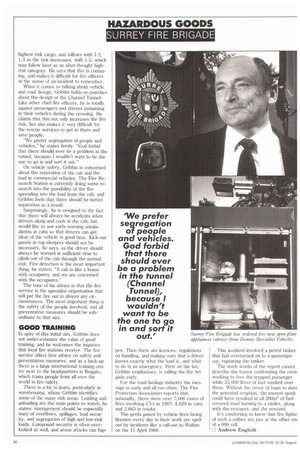HAZARDOUS GOODS SURREY FIRE BRIGADE
Page 48

If you've noticed an error in this article please click here to report it so we can fix it.
highest risk cargo, and follows with 1.2, 1.3 as the risk decreases, with 1.5, which may follow later as an after-thought highrisk category. He says that this is confusing, and makes it difficult for fire officers at the scene of an incident to remember.
When it comes to talking about vehicle and road design, Gribbin holds no punches about the design of the Channel Tunnel. Like other chief fire officers, he is totally against passengers and drivers remaining in their vehicles during the crossing. He claims that this not only increases the fire risk, but also makes it very difficult for the rescue services to get in there and save people.
"We prefer segregation of people and vehicles," he states firmly. "God forbid that there should ever be a problem in the tunnel, because I wouldn't want to be the one to go in and sort it out."
On vehicle safety, Gribbin is concerned about the separation of the cab and the load in commercial vehicles. The Fire Research Station is currently doing some research into the possibility of the fire spreading into the load from the cab, and Gribbin feels that there should be better separation as a result.
Surprisingly, he is resigned to the fact that there will always be accidents when drivers sleep and cook in the cab, but would like to see early-warning smoke alarms in cabs so that drivers can get clear of the vehicle in good time. Kick-out panels in top-sleepers should not be necessary, he says, as the driver should always be warned in sufficient time to climb out of the cab through the normal exit. Fire detection is the most important thing, he states: "A cab is like a house with occupants, and we are concerned with the occupants."
The tone of his advice is that the fire service is the specialist organisation that will put the fire out in almost any circumstances. The most important thing is the safety of the people involved, and all preventative measures should be subordinate to that aim.
In spite of this initial aim, Gribbin does not under-estimate the value of good training, and he welcomes the inquiries that local fire stations receive. The fire service offers free advice on safety and preventative measures, and as a back-up there is a large international training centre next to the headquarters in Reigate, which trains people from all over the world in fire safety.
There is a lot to learn, particularly in warehousing, where Gribbin identifies some of the many risk areas. Loading and unloading are the main points to watch, he states: management should be especially wary of overflows, spillages, load security, and segregation of high and low-risk loads. Compound security is often overlooked as well, and arson attacks can hap pen. Then there are licences, regulations on handling, and making sure that a driver knows exactly what the load is, and what to do in an emergency. First on the list, Gribbin emphasises, is calling the fire brigade early.
For the road haulage industry the message is early and all too often. The Fire Protection Association reports that, nationally, there were over 7,000 cases of fires involving CVs in 1987; 4,620 in vans and 2,663 in trucks.
The perils posed by vehicle fires facing firemen every day in their work are spelt out by incidents like a call-out to Walton on the 11 April 1988. This accident involved a petrol tanker that had overturned on to a passenger car, rupturing the tanker.
The stark words of the report cannot describe the horror confronting the crew working to free the trapped passenger while 32,000 litres of fuel washed over them. Without the cover of foam to dam the potential eruption, the merest spark could have resulted in all 200m2 of fuelcovered road burning to a cinder, along with the rescuers, and the rescued.
It's comforting to know that fire fighte of such a calibre are just at the other eni of a 999 call.
O Andrew English




































































































